The Beautiful and Disconcerting Climate Art of Luciana Abait
Visual investigations at the intersection of climate change and global migration.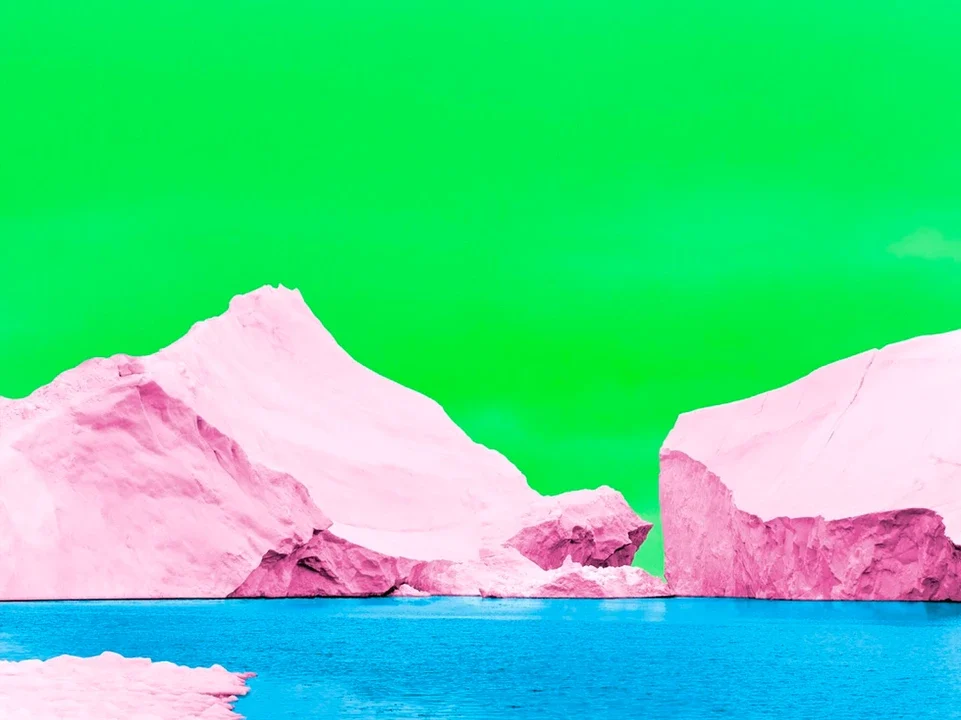
American immigrant artists understandably focus most often on racism, civil and human rights, xenophobia, among many other related topics. These issues affect their lives intimately, often in powerfully negative ways.
Armenian-born artist Zareh, from Glendale, understandably addresses the Armenian genocide and Armenian American artist Arpi Krikorian has used her design work to support Artsakh against aggression from Azerbaijan. In 2021, Japanese-American artist MariNaomi created a Stop AAPI Hate mural in Rosemead, California. There are hundreds of similar examples. These issues affect their lives intimately, often in strikingly negative ways.
Reporting on these creative women and men has too often revealed how they have endured personal affronts as well as the deeper consequences of institutional racism and sexism in America. In recent years, several prominent visual artists have used their creative talents to link those concerns with environmental crises, especially climate change and global warming. They have come to see how changes have deeply and negatively affected their communities. They understand that climate change is deeply linked to their lives as marginalized immigrants –– both in America and in their native lands –– and they have resolved to use and expand their creative powers to draw attention to these vital issues.
Some, such as Los Angeles-based artists Yrneh Gabon Brown and Bernard Stanley Hoyes, both Jamaican-born, have focused on some concrete ways these environmental changes have impacted the communities with which they most closely identify. Their artworks explore how these changes worsen the living conditions of people living there or cause them to leave for more promising opportunities or even survival, in America or Europe.
Abait is an immigrant artist with profound concerns about the natural environment and climate change and their intersection with the urgent crisis of global migration, with its huge cost in human lives and untold suffering.
Argentinian-born artist Luciana Abait creates multimedia works addressing climate change and climate fragility, with a special and highly perceptive focus on immigration in particular.
Her iceberg series, for example, suggests a dramatic analogy between the losses and wanderings of these giant mountainous natural objects and the isolation, displacement and movements of populations, mostly of color, throughout the world in recent decades. Abait’s works are socially conscious, highly aesthetic and pervasively relevant to the dangerous present and impending changes in world climate.
Born and raised in Buenos Aires, she was trained in fine arts in painting and drawing. She emigrated in 1997 to the United States at 26. After further studies in Massachusetts and England, she settled in Los Angeles in 2005. She is an immigrant artist with profound concerns about the natural environment and climate change and their intersection with the urgent crisis of global migration, with its huge cost in human lives and untold suffering. Each of her visual series investigates the intersectionality of climate change and the urgent crisis of global migration, making a unique contribution to the contemporary tradition of socially conscious art. Moreover, beyond her impressive record of international and national museum and gallery exhibitions, she has often deliberately chosen to present her works in public spaces, ensuring that a much wider range of people will have the opportunity to see her creative products.
This is crucial; like many public artists, she understands that viewers in museums, galleries and other conventional art venues are generally limited to relatively privileged, predominantly white members of society. Some of those viewers may be more likely to be better informed, often only slightly, about climate change and global migration because they have better access to more media sources and more time to consume them. Some other audiences are more positioned to reflect on Abait’s messages of environmental and human justice because they are more directly affected by the issues she raises.
Her public project in Inglewood, for example, “Red Smoke–Yellow Sky” (below), shows the dramatic and dangerous impact of global warming on populations of color. Directly above a menswear establishment, it was clearly and easily visible from the street, to drivers and pedestrians alike. Its scheme of glaring yellow in the background being slowly enveloped by reddish smoke sends an unmistakable message of impending danger.
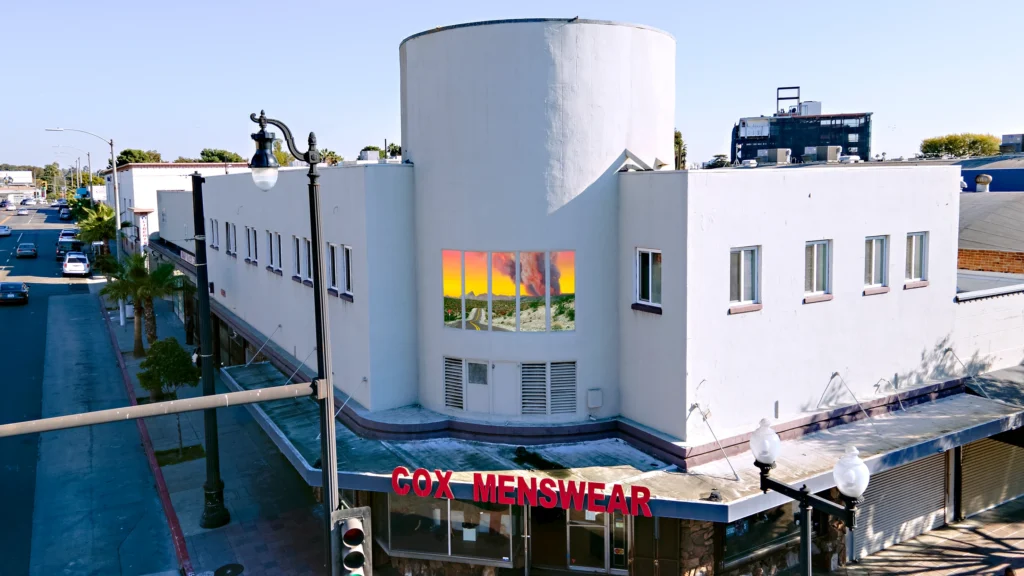
Racial and ethnic minority groups suffer disproportionately from the cheap energy policies in America because rising temperatures, for example, lead to more emergency room visits because poorer communities tend to lack air conditioning. Likewise, their neighborhoods also lack trees, public parks, swimming pools and other amenities that more affluent neighbors take for granted.
Diplomatic negotiations, international conferences, academic papers and any other forums that ignore race when it comes to the effects and harms of climate change are inadequate and can generate incomplete, misleading and insufficient solutions to the crisis. They can ironically exacerbate the problems of global warming and climate change. These are only some of the complex issues posed by global warming and racism that policymakers must face if they truly hope to make serious progress in combating the myriad problems inextricably linked to climate change.
Abait’s Iceberg Series offers an inviting glimpse into her artistic vision. Her works in this series encourage viewers to reconsider nature through her reconstructed and alternate realities. As she notes, they conjure potentially future realities “marked by adaptation and assimilation, isolation and displacement.” She effectively links natural and human experiences in this powerful set of artworks. Scientists and concerned citizens alike throughout the world have noted, with increasing alarm, how glaciers, especially in the Antarctic and Greenland regions, are melting rapidly.
Images from the Iceberg Series are surreal photo-based manipulated landscapes that almost implore viewers to join the millions of environmental activists in the U.S. and elsewhere.
Global warming is a major actor in this distressing natural catastrophe and the longer-term consequences are dire. Sea levels will rise and coastal erosion and flooding will occur in large population areas. Temperatures throughout the world have been rising at dangerous rates, shattering records regularly. Large oil companies are reneging on their rhetorical pledges to challenge climate change; this comes as no surprise to climate activists. Arctic conditions affect weather systems throughout the world and more extreme events are highly probable. Glacial shrinkage causes damage to hundreds of millions of people or more who rely on the ice for water, power and food.
Images from the Iceberg Series are surreal photo-based manipulated landscapes that almost implore viewers to join the millions of environmental activists in the U.S. and elsewhere. Her works in this series show the icebergs as “homeless,” “apart,” “lonely” and “orphaned” –– eerily similar to the millions of human migrants roaming the planet in the early decades of the 21st century. The artist gets her pictures from various sources, including friends, the Internet and elsewhere, and then “draws” and “paints” with pastel and pencil. The results are stunningly aesthetic. They grab viewers’ attention because of their sheer beauty; this is a rare formal feature in the entire history of socially conscious art.
One example is “9-Green Sky/Pink Mountains” (below), a mixed media on canvas effort that is visually overwhelming in its colorful attractiveness. This fusion of lime green for the sky, shades of pink for the melting glaciers and darker and lighter blues for the ocean is effective. A closer view can generate an understanding of the artwork’s social meaning and significance. Imaginative viewers can easily make the jump from the melting icebergs to the plight of people throughout the world. The large pink iceberg is literally tearing apart, just like families throughout the globe.
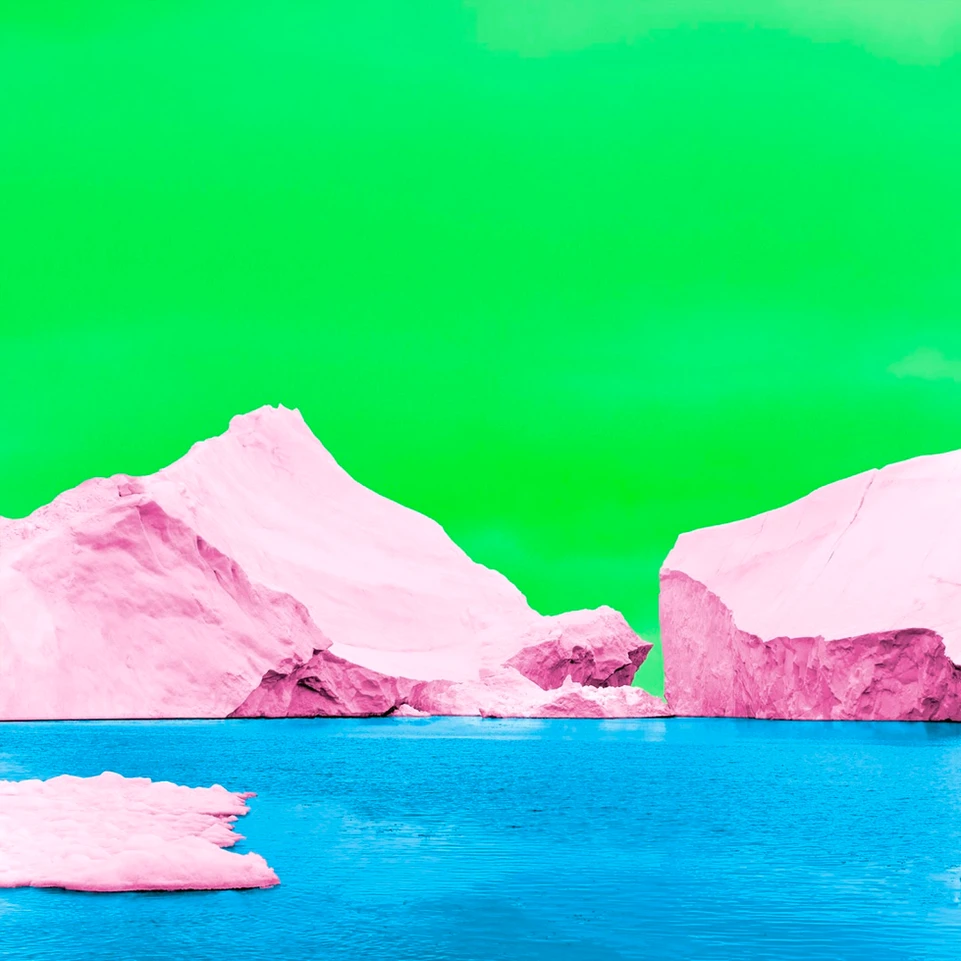
The human implications are both obvious and devastating. The iceberg is a signifier of the dual perils of natural and social calamity. The pink color may be reassuring on the surface, suggesting initially that everything is “okay,” because for most people in the developed world, neither climate changes nor massive demographic shifts with millions of refugees affect them directly –– until they do. Whether “pink” is gentle or calming or only a myth rather than scientifically verifiable, it is widely accepted as such and in the artwork itself adds a strong visual appeal.
The aesthetic quality of the iceberg(s) is likewise significant; it suggests that the lands and nations from which refugees are currently fleeing are attractive, even beautiful, at least on the surface.
Near the center of the composition is one very small connection between the two large ice blocks. That linkage is bound to swiftly disappear, suggesting a comparison to the families in regions where terror, war, civil unrest, sexual violence, intractable poverty and related features of political and social distress have irreparably damaged the quality of their lives. The small pink ice remnant is the orphan, signifying the masses of children, like the unaccompanied minors presenting themselves at the Southern U.S border –– or tragically dying before they arrive. The blue sea is deceptive. It represents the proverbial calm before the storm, masking the horrific turmoil of like the boatloads of refugees from Africa and Haiti who drown in the Mediterranean Sea and Atlantic Ocean unsuccessfully seeking new and dignified lives.
Abait continues her powerful and intriguing visual efforts in the Iceberg Series with “15-Bouy II” (below). This photo-collage using soft pencil on a wood panel effort is likewise highly aesthetic, drawing viewers in through its instant visual appeal.
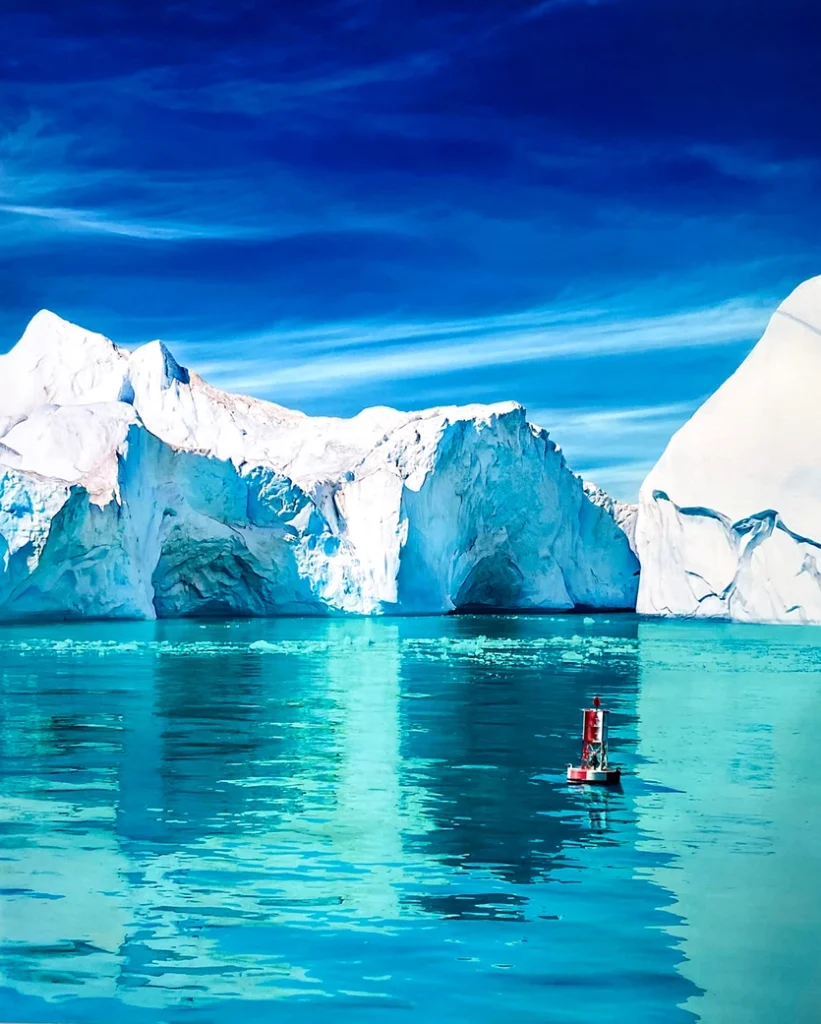
Once again, icebergs are the main focus. In this work, however, she adds a human-made object, a buoy slightly off to the right of the center. That choice is significant. Buoys give passengers directions and warn them of potential dangers in the water. In nautical terms, these dangers are usually hazards and obstructions that can damage the vessels, cargo and people who sail nearby.
The buoy has a deeper meaning applied to the contemporary global-migrant crisis. It stands as a warning, too often unheeded, that nations and world bodies should erect legal “buoys” with enforcement authority to prevent tragedy. Abait’s buoy is a marker for what needs to be done and what, to date, has generally gone without serious response from leaders who are positioned to provide remedies that would save countless lives. The artwork juxtaposes an aspirational vision with the dismal reality on the ground. Instead of a “concrete” buoy, we see an endless proliferation of rhetoric and thoughts and prayers. These hollow gestures are woefully inadequate. Art like this can solve neither the global warming issue nor the world migration issue, but it can issue a loud alarm, probably the best that any work of art can do. Its use of a familiar nautical symbol perhaps can provoke empathetic responses in many viewers.
Abait’s Displacement Series adds further distinction to her linked work on climate change and global migration. This series is deeply informed by her personal immigration history from Argentina to the United States. Because she has dealt with trauma, struggles and a sense of invisibility, she is well positioned to express those experiences and emotions effectively in her artwork. She recalls that people looked at her as “the other,” a perpetual outsider owing to her accent. This generated an internal sense of inferiority, common to many, perhaps most, immigrants arriving in America. Often she refrained from looking at people, and felt that they likewise refrained from looking at her. Abait’s works also address the inadequate political systems and structures that fail to enable humans to cross (arbitrary) geographical frontiers in their quest for decent lives and places that they can call “home.”
A striking example from this series, “The Maps That Failed Us” (below), superimposes a map over what would ordinarily be one of the icebergs presently melting in this era of climate change. The artist uses a pleasing pastel color scheme of greens, light browns and various shades of blues on the crumpled map. A closer view reveals that this iceberg/map provides a high level of detail that illuminates the horrific realities of contemporary migration patterns. At the right of the map, for example, are wrinkled U.S. states that have recently become some of the epicenters of the crisis. Indiana, Ohio and Kentucky have been destinations for undocumented immigrants to the United States. When they arrive, however, they live in constant fear of detection by federal and state officials and subsequent deportation. Meanwhile, they often toil at difficult jobs, with low pay, and are often subject to wage theft, sexual harassment and assault and other forms of job discrimination.

Proceeding further from right to left of this work, after Nevada and Arizona in the center, viewers can find partial maps of the Red Sea and Horn of Africa regions of the world. The mere notation on this work of Ethiopia, Yemen, South Sudan and Saudi Arabia justly evokes images of tens of thousands of displaced persons suffering untold horrors from war, famine, persecution, ethnic cleansing, despotic rule and more. When Abait uses the image of a large iceberg as the backdrop to their unimaginable suffering, audiences begin to understand that their movements both reflect and exacerbate the climate global change crisis.
The figures are horrifying. Hundreds of deaths have already been recorded in 2023 from refugees who have drowned in shipwrecks off the Italian coast.
Proceeding even further to the left, she returns to the United States and Mexico on her superimposed map; it takes close viewing to see those details, but they are important. Mexico is the primary entry point for displaced refugees from that country and from nations throughout much of Central and South America and the Caribbean. It is also the locus of huge controversies –– and hostility –– from conservative forces in the U.S., who mobilize racist and nativist rhetoric in order to keep America as “white” as possible. This migration pattern is likewise the result of climate change as well as a serious contributing factor. Abait uses this unnervingly powerful artwork by crumbling up the map to highlight and signify the enormous complexity of all the issues that need to be urgently addressed. This complexity, visually presented here, is neither easily deciphered nor solved. But we have no choice.
Another work from the Displacement Series suggests that there must be hope both for the individuals caught in the snare of migration and for the possibilities of political and diplomatic solutions to these grave problems. “Map from Displacement Series” (below) is a close-up, extremely detailed view of an Italian map. The world knows that Italy has been, for years, a major entry point for hundreds of thousands of desperate migrants crossing the Mediterranean from North Africa and elsewhere, seeking refuge from lives that are no longer endurable. They feel, correctly, that they have no future in lands where political turmoil, armed conflict, starvation and immediate physical brutality are omnipresent. When they arrive, they scatter throughout Europe, where they have fundamentally altered the life, economy, and culture of that continent. Many have been captured and imprisoned. But that is not the worst of their fates.
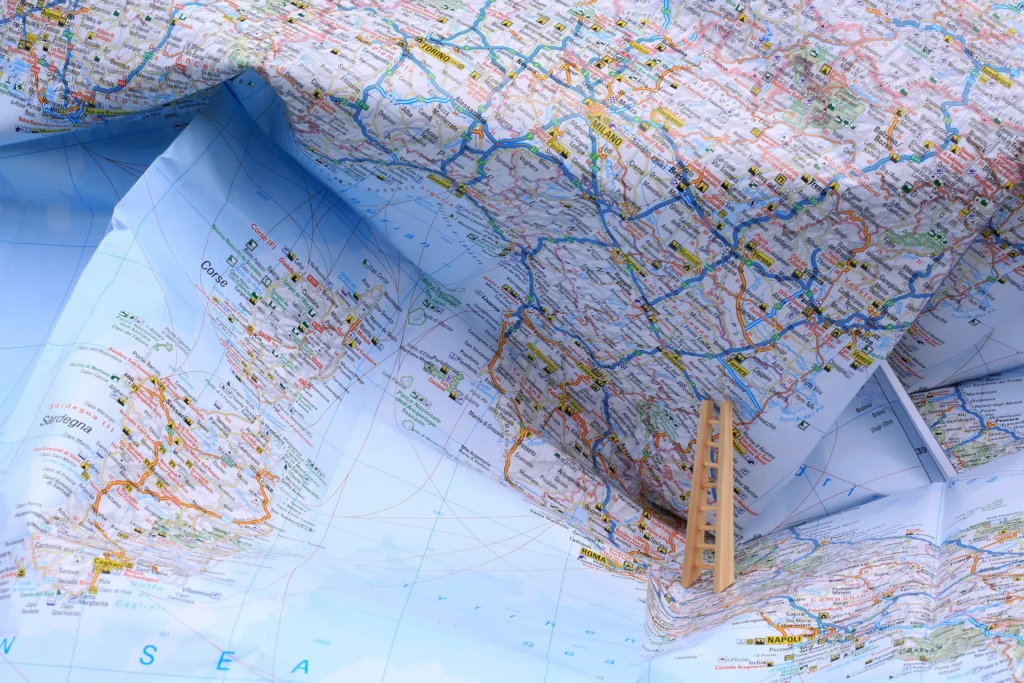
The figures are horrifying. Hundreds of deaths have already been recorded in 2023 from refugees who have drowned in shipwrecks off the Italian coast. Thousands of deaths have occurred over the past decade. These are not abstract figures; they were real people, with hopes, aspirations and dreams for the future for themselves and their loved ones.
Abait adds a very small but vital element to this work: a ladder at the far right of the composition. Made from a child’s toy ladder, the addition signifies what a ladder does in actual life. It provides steps for people who need assistance in their climb to success, even if that success is little more than survival in a new and hostile foreign land. The ladder represents hope, the possibility of building a new, more fruitful existence. Ladders allow persons to elevate themselves, to gain a foothold, to gain a bit of security. At the macro level, the ladder allows leaders to grapple with the refugee problem and its connection to the increasing climate change challenges. Neither problem is easy, yet both must be tackled, and immediately. The ladder is a symbol of opportunity, but opportunities cannot be ignored.
The choice of Italy as the artwork’s content is especially poignant because its present government has acted in striking contrast to the hopeful message that it conveys. Prime Minister Giorgia Melonia’s extreme rightist administration has responded to the massive migration coming into Italy by imposing punitive measures, including long prison terms and outright hostility. This added hardship to fragile human beings is the precise antithesis to what Abait, and now probably hundreds of other socially conscious artists throughout the world, have sought to do with their creative powers.
Art and cultural expressions will not solve the climate crisis and the global migration crisis. What an artist such as Abait can do is to help others, even as modestly as she is able, to become more aware of the gravity of the issues we all face. Perhaps, then, a more conscious populace will become more active citizens and address the intersectionality of race, climate, migration and a multitude of other issues we face in the still early decades of the 21st century.
Your support matters…Independent journalism is under threat and overshadowed by heavily funded mainstream media.
You can help level the playing field. Become a member.
Your tax-deductible contribution keeps us digging beneath the headlines to give you thought-provoking, investigative reporting and analysis that unearths what's really happening- without compromise.
Give today to support our courageous, independent journalists.
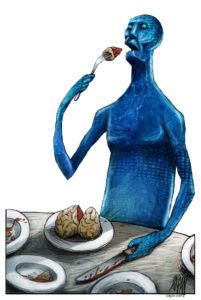
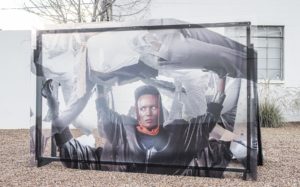


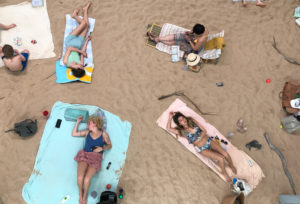
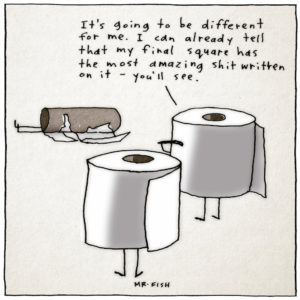
You need to be a supporter to comment.
There are currently no responses to this article.
Be the first to respond.